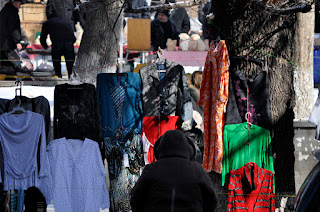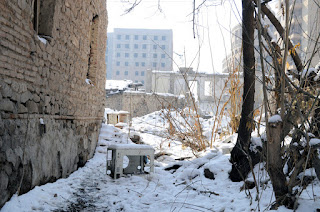Oggi ho terminato l'allestimento della mostra e domani ci sarà l'inaugurazione! Qui di seguito il sunto del progetto e l'invito.
Il progetto che ho sviluppato nel corso della residenza a Yerevan prende avvio dal mio “work in progress” CANT_IERI PROJECT, iniziato un anno fa. L’idea era nata con l’obiettivo di proporre il periodo della Ricostruzione attraverso rielaborazioni di immagini d’epoca che documentavano la distruzione dei cantieri navali della città di Monfalcone durante la seconda guerra mondiale.
Lavorare su queste immagini è stato il mio modo per reagire all’attuale crisi economica ed esprime la volontà di diffondere un messaggio positivo sull’avvenire. L’intervento da me prodotto si ricollega proprio alla valenza positiva del concetto di Ricostruzione: utilizzare il passato per costruire il presente.
Il confronto con la realtà urbana di Yerevan mi porta a ripensare il mio progetto. A Yerevan “la Ricostruzione” è nel presente, ma il valore che esprime è molto diverso, contraddittorio. Non si parte dalle macerie della guerra, ma da quelle dei cantieri edili, responsabili della distruzione e della ricostruzione del tessuto urbano. La voglia di voltare pagina rispetto al passato sovietico e di proiettarsi a capitale moderna è tangibile, ma comporta uno sconvolgimento.
Il centro della capitale, oggi, si arricchisce di enormi nuovi edifici pronti per essere abitati, eppure rimangono vuoti. Zone precedentemente abitate sono state demolite e riprogettate per una classe media che in Armenia ancora non esiste. Ne consegue che alcuni quartieri, come la Northern Avenue, hanno l’ambizione di una promenade commerciale e residenziale, e invece sono delle città fantasma.
Questi appartamenti vuoti rubano dello spazio alla città e negano delle opportunità abitative. La mia riflessione va quindi agli assenti: da una parte ai precedenti abitanti obbligati a lasciare le loro case, e dall’altra a quella parte della popolazione emigrata all’estero che con le loro rimesse contribuiscono al benessere delle loro famiglie in patria.
Il vuoto di questi edifici si riflette nell’assenza di una parte della popolazione, come se i lavoratori emigrati fossero i destinatari di queste abitazioni.
The project that I developed during the residence in Yerevan begins from my CANT_IERI PROJECT "work in progress", started a year ago. The idea was born with the purpose to show the italian Reconstruction time through reworkings of old photos documenting the destruction of shipyards (in Italian "cantieri") of the city of Monfalcone (North East Italy) during the second world war.
Working on these images was my way to react to the current economic crisis, and to express the wish to spread a positive message about the future. My intervention is related to the positive concept of Reconstruction: using the past to build the present.
The confrontation of Yerevan’s urban reality leads me to rethink my project. In Yerevan, "Reconstruction" is in the present, but the value that it comunicates is very different, contradictory. It doesn’t start from the ruins of a war, but from the rubble of building yards, that are responsible for the destruction and reconstruction of the fabric of the city. The desire to turn the page over the Soviet past and projecting modern capital is tangible, but it entails a disruption. The Centre of the capital, today, is enriched with enormous new buildings ready to be inhabited, and yet remain empty. Previously inhabited areas were demolished and redesigned for a middle class that still does not exist in Armenia. Because of that, some quarters, as the Northern Avenue, have the ambition of a residential and shopping promenade, but are ghost towns. These empty apartments steal space to the city and deny housing opportunities. My reflection is about the absence: on the one side the previous inhabitants have been forced to leave their homes, and on the other side a part of the population emigrated abroad to contribute to the well-being of their families at home. The emptiness of these buildings is reflected in the absence of a part of the population, as if migrant workers were the missing inhabitants of these homes.
Cantieri խորագրով այս նախագծի վրա արվեստագետ Էնցո Կոմինը սկսել է աշխատել մոտ մեկ տարի առաջ: Cantieri-ն որոշ տեղանքների, իսկ ավելի ստույգ` Իտալիայի հյուսիս-արեւելքում գտնվող Մոնֆալկոնե քաղաքում տեղակայված կիսաքանդ նավաշինական կառույցների (cantiere) վերակենդանացման, վերակառուցման փորձ է արհեստական/արվեստագիտական ժեստի միջոցով։ Ըստ արվեստագետի, այդ ավերակները խորհրդանշում են 2000-ականների երկրորդ տասնամյակի մատույցներում սկիզբ առած եւ դեռ շարունակվող համաշխարհային տնտեսական ճգնաժամը։ Լուսանկարելով երբեմնի գործող, ռազմավարական կարեւորություն ունեցող, բայց Երկրորդ Համաշխարհային պատերազմի ընթացքում ռմբակոծված եւ ավերված շինությունները` Էնցո Կոմինը այնուհետ ենթարկում էր դրանք “վերակենդանացման”, ծածկելով լուսանկարված ավերակները գեղանկարչական նորովի պատկերներով` արհեստականորեն վերանորոգելով քանդվածը, կորսվածը։ Սա “պոզիտիվին” հարող մի ժեստ էր, որն ի հակադրություն ընթացող ճգնաժամին հուսադրող է եւ խորհրդանշում է վերակենդանացում, վերակառուցում։
Նախկինում հպանցիկ տեղեկացված լինելով Երեւանում տեղի ունեցող սպառողական եւ վերաուրբանացման գործընթացներին, սկիզբ առած 1999-ականների վերջից, Էնցո Կոմինի մեկամսյա այցը Երեւան եւ իրականցված ուսումնասիրությունները թույլ տվեցին ըմբռնել տեղի վերարդիականցման “պրոգրեսիվ” ընթացքների իրական բնույթը, որը տեղի բազմաշատ քաղաքաղացիների եւ իր համամիտ կարծիքով քաղաքաշինության, քաղաքի կազմակերպման պատշաճ լուծումները զանցող գործողություններ են, այն է` շինությունների պլանավորման անհամապատսխանություն, կանաչ գոտիների ոչնչացում, ջենտրիֆիկացիա եւ այլն…
Քաղաքի բնակիչների ճակատագրին է հղում Էնցո ԿոմինիCant-ieri Երեանյան նախագիծը, սկիզբ առած մեկ ամիս առաջ։ Օգտագործելով անցյալ Երեւանի եւ նրա բնակիչների լուսանկարչական պատկերներն, արվեստագետը վրադրում է դրանք այօրվա Երեանի նորակառույցներին, շինարարական կոնստրուկցիաներին` վերակենդանացնելով քաղաքի մասին հիշողությունը, որի անցյալի ֆիզիկական հետքերը հետզհետե մաքրվում են քաղաքային տարածքից, եւ հուշերի նյութական հավաստիությունը մեզ է հասնում լուսանկարված..
Շատերը տարակուսում են, թե արվեստն ի՞նչպես կարող է ծառայել սոցիալական այն քաղաքականություններին, որոնք աշխատում են ապաքրեականացման, կոռուպցիայի եւ հասարակական խնդիրների արդար լուծման ուղղությամբ, բայց ակնհայտ է, որ ինքնավար արվեստի տեսակները, եթե անգամ չլուծեն հարցեր, ապա կարող են տարածել «...քաղաքացիական վարք, ինքնակատարելագործում, տեղային հպարտություն», ինչը տեսնում ենք մերօրյա Երեւանում տեղի ունեցող քաղաքացիական ակտիվիզմի զիլ դրսեւրումներում։
Many wondered how art could serve the social policies aiming at decriminalization and fair resolution of social and corruption issues. Thus, even though such forms of autonomous art might not be able to solve any issues, they still can spread “…civil conduct, self-improvement, local pride.”

























































